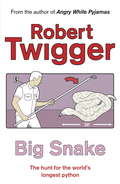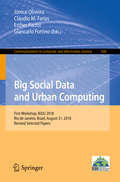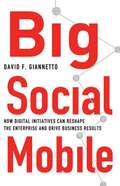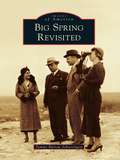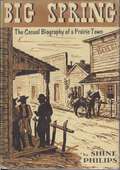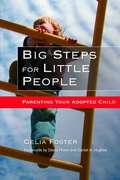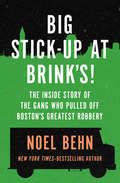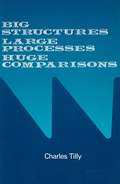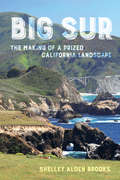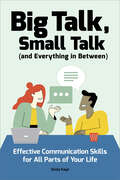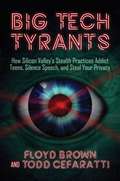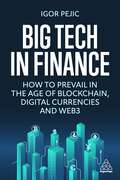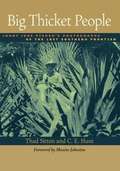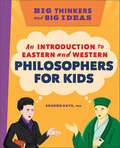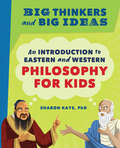- Table View
- List View
Big Snake: Big Snake (HB)
by Robert TwiggerRobert Twigger goes to the Far East in search of the world's longest snake - 'echoes of Gerald Durrell's trips crossed with Redmond O'Hanlon's foray into the heart of Borneo . . . a fantastic book' DAILY MAILAbout to be married, Robert Twigger decides on his last great adventure as a bachelor. Surfing the net, he discovers the Roosevelt Prize - worth $50,000 - for the capture of a live 30 foot python. Armed only with a tin of High Toast Snuff (deadly if sniffed by a snake), Twigger sets off into the remote jungles of Indonesia in search of his prey.Along the way, he investigates the legendarily beautiful women of Sulawesi, treads in Nabokov's footsteps, looks for giant snakes beneath the sewers of Kuala Lumpur, and spends time with a variety of snake catchers and cults. After being caught up in anti-Chinese riots and surviving on greasy civet cat in the jungle, Twigger finally comes face to face with the big one; but the final capture is not quite what he had in mind.
Big Snake: Big Snake (HB)
by Robert TwiggerRobert Twigger goes to the Far East in search of the world's longest snake - 'echoes of Gerald Durrell's trips crossed with Redmond O'Hanlon's foray into the heart of Borneo . . . a fantastic book' DAILY MAILAbout to be married, Robert Twigger decides on his last great adventure as a bachelor. Surfing the net, he discovers the Roosevelt Prize - worth $50,000 - for the capture of a live 30 foot python. Armed only with a tin of High Toast Snuff (deadly if sniffed by a snake), Twigger sets off into the remote jungles of Indonesia in search of his prey.Along the way, he investigates the legendarily beautiful women of Sulawesi, treads in Nabokov's footsteps, looks for giant snakes beneath the sewers of Kuala Lumpur, and spends time with a variety of snake catchers and cults. After being caught up in anti-Chinese riots and surviving on greasy civet cat in the jungle, Twigger finally comes face to face with the big one; but the final capture is not quite what he had in mind.
Big Social Data and Urban Computing: First Workshop, Bidu 2018, Rio De Janeiro, Brazil, August 31, 2018, Revised Selected Papers (Communications in Computer and Information Science #926)
by Giancarlo Fortino Esther Pacitti Jonice Oliveira Claudio M. FariasThis book constitutes the thoroughly refereed proceedings of the First Big Social Data and Urban Computing Workshop, BiDU 2018, held in Rio de Janeiro, Brazil, in August 2018. The 11 full papers presented were carefully reviewed and selected from 40 submissions. The papers are organized in topical sections on urban mobility, urban sensing, contemporary social problems, collaboration and crowdsourcing.
Big Social Mobile
by David F. GiannettoBig Social Mobile shows that big data, along with social and mobile media, can improve enterprise performance significantly, but only when implemented in a holistic fashion. This book offers an integrative process that has helped a wide range of businesses enhance what has traditionally made them unique, resulting in transformative results.
Big Spaceship: Ready to Go Big?
by Boris Groysberg Michael SlindBig Spaceship, a digital marketing agency, faced a rather big challenge: How to scale the distinctive culture that was essential to its competitive strategy? Renowned for the cutting-edge web sites that it developed to market major Hollywood movies and leading consumer brands, the firm had won numerous awards and garnered considerable attention within the advertising industry. In mid-2008, Big Spaceship remained small (it had fewer than 50 employees) but was poised for significant growth. For founder and CEO Michael Lebowitz, the central challenge was to figure out whether and how the agency could retain its boutique culture while transcending its boutique size. The case begins by briefly outlining Lebowitz's background, along with the history of Big Spaceship since its founding in 2000. Then the case shifts to a discussion of external dynamics: the firm's value proposition, which focused on providing start-to-finish, strategy-driven digital marketing solutions; its interaction with clients; and its relationship with established players in the advertising industry. Next, the case examines the firm's internal dynamics. Here, in addition to describing the culture of Big Spaceship, the case puts special emphasis on the firm's recent shift from a functional structure to a team-based structure. Finally, the case provides an overview of key issues that Lebowitz and his team must consider as they plan for the firm's growth--how to raise capital, how to gauge the optimal size for the company, how to manage an expanding staff. A major highlight of the case is the inclusion of more than a dozen graphically compelling exhibits, which help to illustrate the firm's value proposition, its innovation-oriented culture, and its evolving organizational design.
Big Spaceship: The Evolving Agency
by Boris Groysberg Matthew Preble"Big Spaceship: The Evolving Agency," discusses the evolution of Big Spaceship, an advertising and marketing agency, from a product-focused business to a relationship-oriented one as clients seek deeper and more meaningful long-term partnerships. The 15 year-old company had already evolved multiple times over its history as new technological platforms and services emerged to change the way people communicated and received information, and as the broader advertising industry changed. New and more aggressive competitors were emerging, and the industry was quickly consolidating. Big Spaceship had adjusted its strategy, organizational structure, and human capital accordingly. The company's founder and CEO, Michael Lebowitz, now wondered what he needed to do to keep his company competitive in the years to come. Had he found the right way to organize his people and structure the organization following the transition from project-based to relationship-based work, or were further changes necessary? How could he keep people engaged as the nature of the work evolved in some instances to become more predictable? What new systems and processes were needed to ensure a steady output of high quality work? Lebowitz was proud that the organization had retained a distinctly different feel from, and approach to work than, traditional advertising agencies, and Lebowitz and his colleagues wanted to maintain these intangible elements as the company evolved. But was this incompatible with his business goals?
Big Spaceship: The Evolving Agency
by Boris Groysberg Matthew Preble"Big Spaceship: The Evolving Agency," discusses the evolution of Big Spaceship, an advertising and marketing agency, from a product-focused business to a relationship-oriented one as clients seek deeper and more meaningful long-term partnerships. The 15 year-old company had already evolved multiple times over its history as new technological platforms and services emerged to change the way people communicated and received information, and as the broader advertising industry changed. New and more aggressive competitors were emerging, and the industry was quickly consolidating. Big Spaceship had adjusted its strategy, organizational structure, and human capital accordingly. The company's founder and CEO, Michael Lebowitz, now wondered what he needed to do to keep his company competitive in the years to come. Had he found the right way to organize his people and structure the organization following the transition from project-based to relationship-based work, or were further changes necessary? How could he keep people engaged as the nature of the work evolved in some instances to become more predictable? What new systems and processes were needed to ensure a steady output of high quality work? Lebowitz was proud that the organization had retained a distinctly different feel from, and approach to work than, traditional advertising agencies, and Lebowitz and his colleagues wanted to maintain these intangible elements as the company evolved. But was this incompatible with his business goals?
Big Spring Revisited
by Tammy Burrow SchrecengostIn West Texas, the land that would one day become Big Spring was originally home to Comanche Indians. In 1880, the Texas Rangers were sent ahead of the railroad to establish peace among the ranchers and to protect the western frontier from the Comanche who lived there. New Texans began to follow the railroad from Colorado City to Big Spring, which was named the county seat of Howard County in 1882. The small Texas town once known for its saloons, dance halls, shoot-outs, and gambling grew into an oil- and agriculture-rich community. This pictorial collection illustrates the continual progress that Big Spring has made, from the first wooden buildings thrown together on First and Main Streets to the discovery of oil. Big Spring also experienced economic booms with the building of an oil refinery, an air force base, and the rise of the cattle industry. Today this once-small West Texas town is dotted with wind farms, an oil refinery, and three hospitals.
Big Spring and Howard County
by Tammy Burrow SchrecengostWhile Native Americans had been visiting the oasis at the cross roads of the Comanche War Trail for hundreds of years, Captain Randolph Marcy was the first White man to "discover" the springs on October 3, 1849. Settlers moved their families to the area, and the region quickly developed into a ranching and farming community. Captured here in over 200 vintage images are the trials and triumphs of settlers and residents to build a life in Big Spring and the towns of Howard County.As the first settlers began setting up stakes in the region, a tent city was built at the springs while awaiting the arrival of a railway. Once the train was in service, Big Spring began to develop more permanent dwellings; schools, churches, and a newspaper were established, followed quickly by the building of hotels and banks and the formation of a local government. Featured here are over 150 years of the region's residents, homes, and social events, covering the many towns and communities of the County such as Forsan, Coahoma, Lomax, Elbow, Garden City, Knott, Vealmoor, Ackerly, and Vincent.
Big Spring: The Casual Biography of a Prairie Town
by Shine PhilipsBig Spring: The Casual Biography Of A Prairie Town is a non-fiction book written by Philips Shine. The book provides a detailed account of the history of a prairie town called Big Spring. The author takes the readers on a journey through time, starting from the early days of the town's establishment to the present day. The book is divided into several chapters, each covering a specific period in the town's history. The author describes the town's growth and development, the challenges it faced, and the people who played a significant role in shaping its destiny. The book also highlights the town's cultural and social aspects, including its festivals, traditions, and customs. The author uses a casual writing style, making the book easy to read and understand. The book is well-researched, and the author provides a wealth of information about the town's history. The book is also accompanied by several photographs, which help to bring the town's history to life. Overall, Big Spring: The Casual Biography Of A Prairie Town is an excellent book for anyone interested in the history of small towns in America. The book provides a fascinating insight into the life of a prairie town and its people, making it a must-read for history enthusiasts.-Print ed.
Big Steps for Little People: Parenting Your Adopted Child
by Daniel Hughes David Howe Celia Foster'This book is full of the techniques that we have used successfully over the years. Many we have adapted to suit their needs and many we have made up ourselves. What we have become particularly good at is not giving up!' A mother of two adopted children, Celia Foster wrote Big Steps for Little People as a personal `insider's guide' to parenting adopted children. Drawing on the hard-won wisdom gained in her own family life, the book offers a thoughtful account of life with adopted children and examines the issues that many adoptive families encounter, including the development of children with attachment problems and how to tackle behavioural difficulties. It combines real-life anecdotes with suggestions and strategies that other parents can put to use. This book will be a great comfort and help to all adoptive families and offers insights for the professionals who work with them.
Big Stick-Up at Brink's!: The Inside Story of the Gang Who Pulled Off Boston's Greatest Robbery
by Noel BehnA riveting and frequently hilarious insider account of one of the twentieth century&’s most outrageous capers. On the evening of January 17, 1950, armed robbers wearing Captain Marvel masks entered the Brink&’s Armored Car building in Boston, Massachusetts. They walked out less than an hour later with more than $2.7 million in cash and securities. It was a brazen and expertly executed theft that captured the imaginations of millions of Americans and baffled the FBI and local law enforcement officials. But what appeared on the surface to be the perfect crime was, in fact, the end result of a mind-boggling series of mistakes, miscalculations, and missteps. The men behind the masks were not expert bank robbers but a motley crew of small-time crooks who bumbled their way into a record-breaking payday and managed to elude the long arm of the law for six years. New York Times–bestselling author Noel Behn tape-recorded nearly one thousand hours of interviews with the surviving robbers, including motormouthed mastermind Tony Pino, a character so colorful he might have been dreamed up by a Hollywood screenwriter, to tell the uncensored story of the heist forever known as &“the Great Brink&’s Robbery.&” Fun and suspenseful from first page to last, Behn&’s true-crime classic was the basis for The Brink&’s Job (1978), the Academy Award–nominated film directed by William Friedkin and starring Peter Falk and Peter Boyle.
Big Sticks: The Batting Revolution of the Twenties
by William CurranBig Sticks is an exhilarating account of the home-run barrage of the twenties and its most illustrious purveyor, Babe Ruth. William Curran recreates all the excitement of the decade when the long ball first came into fashion and baseball was changed forever into a hard-hitting offensive game. Although most fans are familiar with the greatest stars of the past, many are unfamiliar with the actual achievements of men like Ty Cobb, George Sisler, Lou Gehrig, Rogers Hornsby, and even Babe Ruth. Curran gives us the stories of these hitters' greatest moments in the years of their greatest glory--years when teams scored an average of 11 runs a game, when a .374 hitter could be shipped back to the minors, years of unprecedented, and unequaled, hitting. The understood explanation for this power surge has been the notion that the ball changed in 1920. Curran comes up with his own reasons--Ruth's new style of swing, copied from Joe Jackson; the outlawing of the spitball, which put pitchers at a great disadvantage; the use of clean baseballs after Ray Chapman was beaned by a dirty, uncontrollable ball and died--and in so doing explodes the myth of the rabbit ball. Big Sticks is the first book to chronicle a decade that started with a Ruthian wallop and rose to a crescendo in 1930 before rules changes and slight changes in the ball tempered the triumphs of the twenties.
Big Structures, Large Processes, Huge Comparisons
by Charles TillyThis bold and lively essay is one of those rarest of intellectual achievements, a big small book. In its short length are condensed enormous erudition and impressive analytical scope. With verve and self-assurance, it addresses a broad, central question: How can we improve our understanding of the large-scale processes and structures that transformed the world of the nineteenth century and are transforming our world today? Tilly contends that twentieth-century social theories have been encumbered by a nineteenth century heritage of “pernicious postulates.” He subjects each misleading belief to rigorous criticism, challenging many standard social science paradigms and methodologies. As an alternative to those timeless, placeless models of social change and organization, Tilly argues convincingly for a program of concrete, historically grounded analysis and systematic comparison. To illustrate the strategies available for such research, Tilly assesses the works of several major practitioners of comparative historical analysis, making skillful use of this selective review to offer his own speculative, often unconventional accounts of our recent past. Historically oriented social scientists will welcome this provocative essay and its wide-ranging agenda for comparative historical research. Other social scientists, their graduate and undergraduate students, and even the interested general reader will find this new work by a major scholar stimulating and eminently readable. This is the second of five volumes commissioned by the Russell Sage Foundation to mark its seventy-fifth anniversary. "In this short, brilliant book Tilly suggests a way to think about theories of historical social change....This book should find attentive readers both in undergraduate courses and in graduate seminars. It should also find appreciative readers, for Tilly is a writer as well as a scholar." —Choice
Big Sur: The Making of a Prized California Landscape
by Shelley Alden BrooksBig Sur embodies much of what has defined California since the mid-twentieth century. A remote, inaccessible, and undeveloped pastoral landscape until 1937, Big Sur quickly became a cultural symbol of California and the West, as well as a home to the ultrawealthy. This transformation was due in part to writers and artists such as Robinson Jeffers and Ansel Adams, who created an enduring mystique for this coastline. But Big Sur’s prized coastline is also the product of the pioneering efforts of residents and Monterey County officials who forged a collaborative public/private preservation model for Big Sur that foreshadowed the shape of California coastal preservation in the twenty-first century. Big Sur’s well-preserved vistas and high-end real estate situate this coastline between American ideals of development and the wild. It is a space that challenges the way most Americans think of nature, of people’s relationship to nature, and of what in fact makes a place “wild.” This book highlights today’s intricate and ambiguous intersections of class, the environment, and economic development through the lens of an iconic California landscape.
Big Talk, Small Talk (and Everything in Between): Effective Communication Skills for All Parts of Your Life
by Shola KayeLearn the art of effective communication with skill-building strategies and tools Effective communication doesn't come naturally to everyone, but the good news is you can get better at it with practice and the right tools. Big Talk, Small Talk (and Everything in Between) is filled with strategies to help you build communication skills and put them into practice in everyday interactions with friends, family, work colleagues, acquaintances, and even strangers. Communicating effectively can create opportunities in your life, foster relationships that wouldn't have existed otherwise, and smooth over awkward or stressful interactions. Learn how to make engaging small talk and incisive big talk, translate body language and facial expressions, and improve visual and written skills. You'll find practical tips that help you get the most out of each strategy, scenarios that illustrate each technique in practice, and more. This book for building effective communication skills includes: Communication 101—Learn about the social importance of effective communication skills and the different ways we communicate. 46 Skill-building strategies—Discover a wide range of tips and tools to help you establish communication skills for any social situation. Real-life scenarios—Explore a variety of common situations where effective communication skills are important, like sparking up a conversation with a stranger or letting someone know they hurt your feelings. Build strong communication skills with Big Talk, Small Talk (and Everything in Between).
Big Tech Firms and International Relations: The Role of the Nation-State in New Forms of Power (Contributions to International Relations)
by Li ShengThis book presents cutting-edge research and exploration of the role of nation-state when big tech firms present themselves as new participants in contemporary international relations that act on an equal footing with nation-states. The general research goal of this book is to identify the justifications that nation-states have adopted to regulate the big tech firms and the impacts of this process on international trade in the main economies in the world. With the massive instrumentation of data, big tech firms have become actors with the capacity to intervene not only in economies but also, above all, in the politics of different countries with different systems. The emergence of big tech firms has transformed the approach to the concepts of national security, information management and access to new technologies among nation-states. The principles and fundamentals of cyber sovereignty have become one of the bases of states in the contemporary system of international relations. Today, the influence of big tech firms in different societies in the contemporary world is one of the main forms of power. This book tries to collect and present the recent state of the art in studies on the relationship between big tech firms and nation-states in the literature. It also addresses how governments such as those of the US, China and the EU are changing their legislation, creating control and data security mechanisms, imposing entry restrictions on foreign companies, and regulating the actions beyond the cloud of big tech firms inside and outside their borders.
Big Tech Tyrants: How Silicon Valley's Stealth Practices Addict Teens, Silence Speech, and Steal Your Privacy
by Floyd Brown Todd CefarattiThey are driven without respect for the lives they are changing…“Boy Kings,” or Big Tech Tyrants, are considered the most powerful individuals in the world. They’re the autocratic aristocrats who run the tech giants in Silicon Valley, and if the labels are accurate, they suggest these social platform operators have gained a non-elected (or, should we say, a self-elected) authoritarian power. They wield it with more effectiveness and precision than any sitting government or military strategist. Big Tech Tyrants boast riches beyond emperors of old but act like juveniles who don’t want to grow up. They are modern-day robber barons. Big Tech Tyrants don’t know the meaning of privacy, when it comes to you. They try to make you believe they will give their products away for free as a service to society, when really, they are vacuuming your personal data. They use this data to discover your deepest secrets. Are you or your partner trying to get pregnant? Are you underwater financially? Are you having an extramarital affair? Do you have a tidy nest egg? Are you a Trump supporter? Are you a Bernie Sanders follower? Are you a Scientologist, Mormon, Christian, or Buddhist? Your personal data is extremely valuable to them—and they use it—and abuse. These tyrants knowingly addict users to make more money. Not only that, they also consider themselves the most enlightened the world has ever seen—so they know what’s best for you to see—from the news and information you read to the political candidates they think you should vote for. They censor news and only let you see what they want you to see. This is an eye-opening must read for anyone living in the twenty-first century!
Big Tech in Finance: How To Prevail In the Age of Blockchain, Digital Currencies and Web3
by Igor PejicWith Big Tech's breakthrough into finance with blockchain, it is imperative that finance players understand the ramifications and how they can defend their competitive advantage.Big Tech in Finance provides a cutting edge look at Big Tech's play for domination of the crypto economy, its ramifications and how finance is fighting back. The book analyses the motives behind Big Tech's break into banking and unpicks the strategies behind the use of blockchain, technology interfaces, infrastructure and investments into blockchain unicorns. The book then goes onto review how organizations in finance are countering these threats, with governments and banks driving their own strategies and use of centralized blockchains. Delving into the fight between Big Tech, Big Banking, start-ups, and regulators, Big Tech in Finance analyzes which actors have the best shot at succeeding. It explores the key tools in play, such as smart contracts, digital central bank currencies, decentralized autonomous organizations (DAOs) and the metaverse. The book also divulges the geopolitical dimensions underpinning the power struggle and its implications for the industry. Written by an internationally recognized expert on blockchain, the book draws on in-depth interviews with founders, investors, regulators, bankers and blockchain experts to provide valuable insider insights. This will be an essential read for finance and fintech professionals, bankers and investors and anyone else interested in the developments of fintech.
Big Tent: The Story of the Conservative Revolution—As Told by the Thinkers and Doers Who Made It Happen
by Ed FeulnerDrawing from his comprehensive, star-studded course at the Citadel, Mallory Factor, the New York Times bestselling author of Shadowbosses, brings together a fascinating and diverse range of essays from leading figures and activists which explore and illuminate the conservative intellectual tradition in American politics.Ambitious in its breadth and depth, The Big Tent is a panoramic portrait of the intellectual history of the conservative movement. Some of the leading lights of the right offer an unparalleled introduction to conservative figures and ideas, from the Revolution to William F. Buckley; Barry Goldwater to the Reagan Revolution; Libertarianism to the War on Terror.Insightful and stimulating, The Big Tent is an outstanding survey of the movement over three centuries.
Big Thicket People
by Thad Sitton C. E. HuntLiving off the land-hunting, fishing, and farming, along with a range of specialized crafts that provided barter or cash income-was a way of life that persisted well into the twentieth century in the Big Thicket of southeast Texas. Before this way of life ended with World War II, professional photographer Larry Jene Fisher spent a decade between the 1930s and 1940s photographing Big Thicket people living and working in the old ways. His photographs, the only known collection on this subject, constitute an irreplaceable record of lifeways that first took root in the southeastern woodlands of the colonial United States and eventually spread all across the Southern frontier. Big Thicket People presents Fisher's photographs in suites that document a wide slice of Big Thicket life-people, dogs, camps, deer hunts, farming, syrup mills, rooter hogs and stock raising, railroad tie making, barrel stave making, chimney building, peckerwood sawmills, logging, turpentining, town life, church services and picnics, funerals and golden weddings, and dances and other amusements. Accompanying each suite of images is a cultural essay by Thad Sitton, who also introduces the book with a historical overview of life in the Big Thicket. C. E. Hunt provides an informative biography of Larry Jene Fisher.
Big Thinkers and Big Ideas: An Introduction to Eastern and Western Philosophers for Kids
by Sharon KayeAn introduction to 25 major philosophers for kids ages 8 to 12 Learning about philosophy encourages kids to ponder big ideas and ask deep questions about the world around them. This book introduces kids to 25 major Eastern and Western philosophers with easy-to-understand explanations of their most well-known ideas.What sets this book about philosophy for kids apart:An introduction to philosophy—Kids will learn more about what a philosopher is, what kind of questions they ask, and the history of Eastern and Western philosophy.Thinkers throughout time—This book covers ancient philosophers like Socrates and Confucius, medieval philosophers like Averroes and Hildegard of Bingen, and modern philosophers like Simone de Beauvoir and Mohandas Gandhi.Thought-provoking questions—Get kids thinking with philosophical questions that help them consider opposing ideas, develop strong arguments, and strengthen their communication skills.Pick up this kid-friendly choice in philosophy books and inspire the budding philosopher in your life.
Big Thinkers and Big Ideas: An Introduction to Eastern and Western Philosophy for Kids
by Sharon Kaye Ph.D.An introductory guide to Eastern and Western philosophy for kids ages 8 to 12 Philosophy is both fun and good for kids' brains, as it encourages them to think deeply and develop their own solutions to complex problems. With this colorful book about philosophy for kids, they'll learn all about introductory concepts and important thinkers in a way that's fun and approachable, but still in-depth and substantial. Your child will explore questions like: "What is real?", "How do I know something is true?", "How can I be a good person?", and "If this is true, what else is true?" A detailed glossary offers easy-to-understand definitions for the more advanced words and ideas in the book. Dive into philosophy for children with: An intro to philosophy—Get essential information about the origins of philosophy, the different branches, and the benefits of studying it. The four main branches—Discover the main branches of philosophy: metaphysics (reality), epistemology (knowledge), logic (critical thinking), and ethics (values). Philosopher profiles—Learn about different kinds of philosophy from all over the world and details about philosophers like Socrates, Pythagoras, Nancy Fraser, and Neil deGrasse Tyson. Inspire your child to think deeply with this perfect introduction to philosophy for kids.
Big Thoughts for Little Thinkers: The Gospel
by Joey AllenThe most foundational teachings of the Christian faith are presented in the Big Thoughts for Little Thinkers series at a level preschool and elementary children can understand. In simple and precise language, God-centered theology is promoted, giving children a firm foundation in God's timeless truth. The Gospel relates the good news of salvation to children, at their level of understanding. Even children can grasp God's saving love and His promise to adopt them and give them a home in heaven through faith in Jesus Christ. Full-color Interior * Ages 4-8
Big Thoughts for Little Thinkers: The Mission
by Joey AllenThe most foundational teachings of the Christian faith are presented in the Big Thoughts for Little Thinkers series at a level preschool and elementary children can understand. In simple and precise language, God-centered theology is promoted, giving children a firm foundation in God's timeless truth. The Mission presents God's worldwide plan to call people from every nation to worship Him through Jesus Christ. God invites children to share His good news with a world of people who desperately need a Savior. Full-color Interior * Ages 4-8
